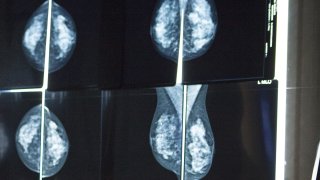
In a revealing essay, former TODAY co-anchor Katie Couric shared that she was diagnosed with stage 1A breast cancer this summer.
Couric underwent a lumpectomy to remove the tumor and learned that her cancer was actually larger than doctors initially suspected. "Thankfully, my lymph nodes were clean," Couric wrote on her blog. "But the tumor was bigger than they expected: 2.5 centimeters, roughly the size of an olive."
Get top local stories in Southern California delivered to you every morning. Sign up for NBC LA's News Headlines newsletter.
That discovery left her with the diagnosis of stage 1A breast cancer. Knowing her stage and, later, the exact type of cancer she had, helped direct her treatment, which would eventually include radiation and long-term medication.
What do different cancer stages mean?
Correctly staging breast cancer is "really important" because "the way you would approach the treatment would be different depending on the stage," Dr. Jason Mouabbi, an assistant professor in the department of breast medical oncology at the University of Texas MD Anderson Cancer Center, told TODAY.
U.S. & World
News from around the country and around the globe
Breast cancer stages start at stage 1 (the earliest and, usually, most treatable stage) and go up to stage 4, Mouabbi explained. Stage 1 and 2 are considered early stage, stage 3 is considered advanced and stage 4 is metastatic.
And while doctors can get a sense for what stage a cancer may be in through physical exams and imaging, but it's only through surgery that they can confirm the diagnosis, Dr. Michael Zeidman, assistant professor of surgery and breast surgeon at Mount Sinai Brooklyn, told TODAY.
"The stage of breast cancer is mainly comprised of two parts: the size of the cancer and whether or not it's spread to the lymph nodes," Zeidman said. "And we don't have the answer to either one of those questions until after surgery."
What is stage 1A breast cancer?
"Stage 1 indicates that it is the earliest stage of breast cancer," Mouabbi said. At this stage, the tumor is less than 2 centimeters in size and, most likely, has not spread to the lymph nodes.
To find out how far the cancer has spread, during surgery, the surgeon will "sample a few of the lymph nodes" with a procedure called a sentinel lymph node biopsy, Zeidman explained.
Using this procedure, the surgeon injects a radiotracer compound into the breast that will "travel to the lymph nodes and provide a roadmap," he said. "It'll show me, if cancer were to spread to the lymph nodes, which would be the first few lymph nodes that it would spread to."
From there, doctors will remove and biopsy those lymph nodes to determine whether or not "tiny clusters of cells" have accumulated there, Zeidman said.
If the cancer hasn’t spread to the lymph nodes, it will be considered stage 1A. But if a small amount has spread to one of the lymph nodes, the cancer is considered stage 1B, Mouabbi said. (If there is a more significant amount of cancer in the lymph nodes, the cancer is automatically considered stage 2 or 3 regardless of the size of the primary tumor, he added.)
Crucially, stage 1A and stage 1B cancers are treated generally the same way, Zeidman said.
How is stage 1A breast cancer treated?
Patients with stage 1 breast cancer typically undergo surgery upfront, Mouabbi said, which may be a breast-conserving surgery (lumpectomy) or a mastectomy.
Surgery essentially "puts the patient in a cancer-free state because the cancer is removed already," Mouabbi said. "So I tell my patients, everything that comes after that step is prevention — making sure the cancer does not come back."
But the exact treatments involved depend on a few factors. For instance, if a patient opted for a lumpectomy, they will likely receive radiation after surgery, Zeidman said. And if the patient's cancer did spread to nearby lymph nodes they may receive radiation to "the regional lymph nodes around the breast," Mouabbi explained.
And, in a subset of patients with specific types of breast cancer, chemotherapy may be recommended, Mouabbi said.
What to know in the long-term
Stage 1A breast cancer is a generally favorable and treatable diagnosis, the experts said. But it does still involve long-term care and consideration.
Depending on the type of breast cancer, patients may need to take medication — endocrine therapy, also called anti-hormone therapy — for five to 10 years. For most stage 1 patients, though, it's just five years, Mouabbi said. (Couric noted that her cancer is hormone receptor-positive and HER2-negative, for example, which suggests the need for endocrine therapy.)
People who've had stage 1 breast cancer also need to stay on top of screening in the future, the experts said.
"The highest risk factor for another breast cancer is a prior history of breast cancer," Mouabbi said. That's why it's so important that, once a cancer patient is in remission, they continue regular breast cancer screening, including mammograms and physical exams.
"The most important thing is catching cancer in this early stage," Ziedman agreed, adding that some people with a family history or genetic risks for cancer may need to start regular screenings much earlier.
This story first appeared on TODAY.com. More from TODAY:



